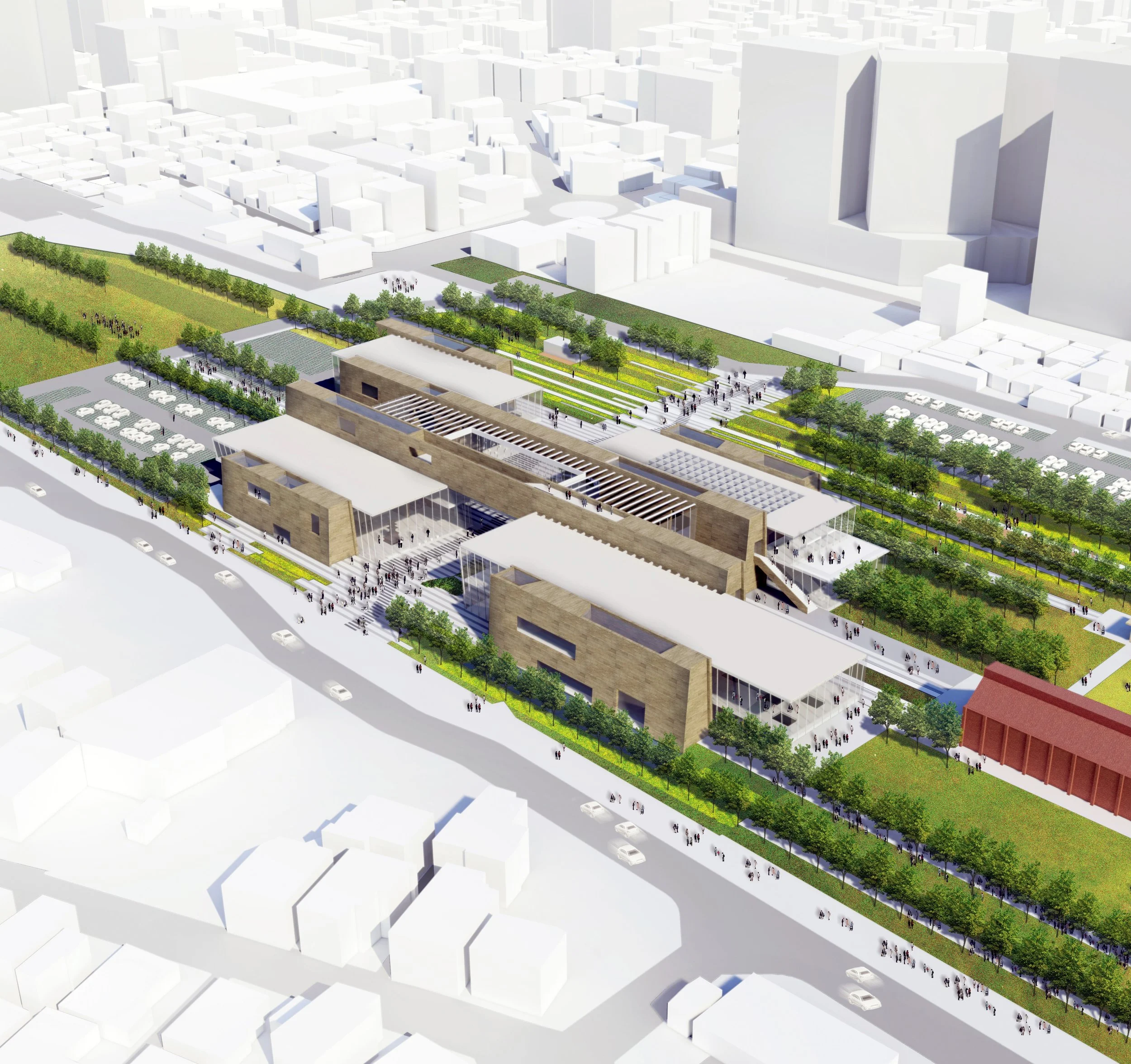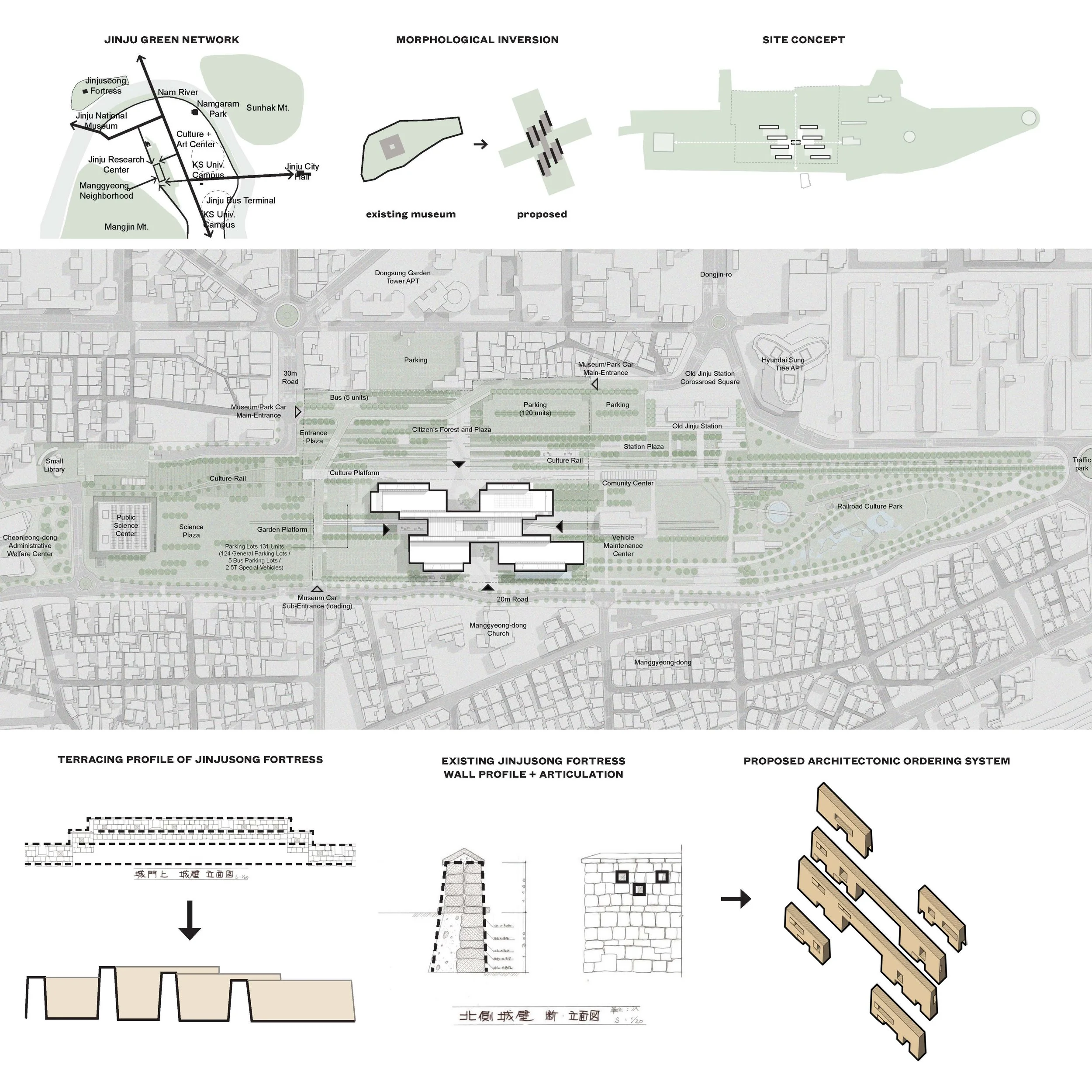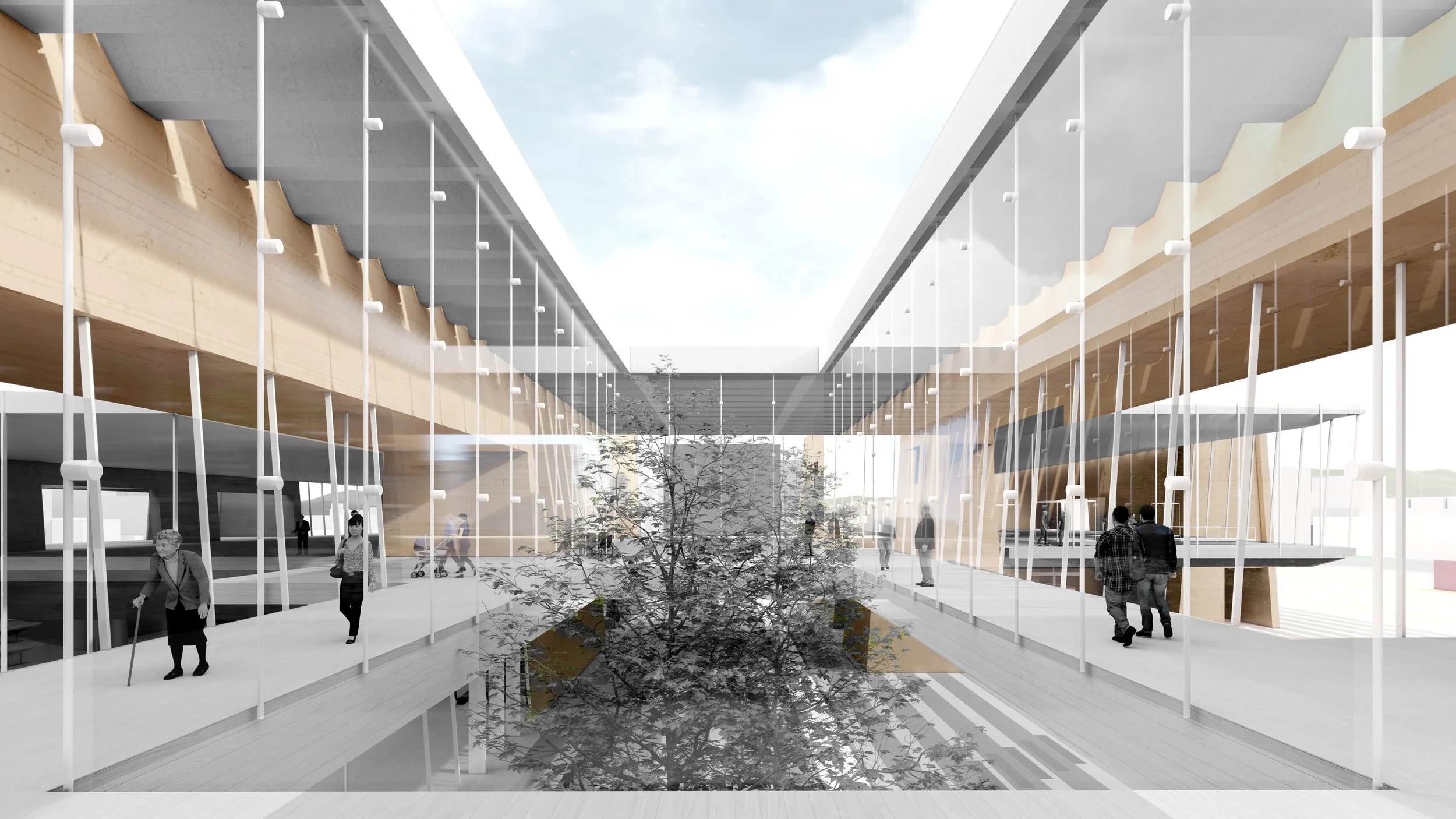Client // City of Jinju • Location // Jinju, Korea • Program // Museum and Cultural Center • Status // Competition Proposal / 2023 • Area // 15,000m2 • Team // Strange Works Studio, Emergent Studio, MMK+
Inverted Museum as a Communicative Urban Interface
A gateway is a memorable, iconic form. It is unique, in that it is both open and closed. It connects two different conditions. It is directionally specific and has the potential to connect or divide what is on either side. It has thickness and forms a border where one can occupy neither of the two mediated conditions, but a separate zone that is somewhere in between.
Our proposal imagines an open landmark that gathers community to its center while mediating the complex connections and orientations of the formal railway site. We propose the formal and spatial motif of the wall and threshold as an opportunity to establish specific visual, physical, and typological relationships between the museum and its surroundings. Rather than a monolithic object in a park or a transparent vessel without boundaries and without identity, this proposal argues that the relationship between park and museum is enriched by creating a distinct zone of transition between the two. Evoking the formal and spatial legacy of Jinjusong Fortress, the morphology of the perimeter wall is subverted to create zones of ambiguity rather than a distinct perimeter. The proposal simultaneously remembers the institutional history of the museum, the history of Jinju as a site of military conflict, and the linearized morphology of the site as a former railway yard.
Urban Strategy
As an urban type, the gateway was, and still is, a moment of exchange in the urban fabric. The thickness of a wall creates a period of transition, passing from one region to another in the city. Historically, gateways formed border zones between distinct urban ecologies, serving as gathering points for diverse publics and as critical spaces of communication and exchange. Our proposal inverts the typical museum type from a moment of arrival to a series of thresholds where unpredictable interactions and experiences might occur. The sequence through the city is not concluded upon arrival at the museum lobby but is an ongoing, continuous experience.
The site suggests important connective axes in two directions. As a historical boundary between neighborhoods on the east and west, the project must provide a connective border condition between the two. As the central site along a linear masterplan ranging from north to south, the project must provide continuity and connectivity derived from the existing railway morphology. Our proposal acknowledges these two key connective requirements, but argues that they are not the same, and cannot be dealt with through the same spatial devices. East-west, the project provides a gateway and a series of spatial thresholds to create a sense of transition, complexity, and interface between different conditions. East-west the project is a series of perforated, layered facades that control view (of local monuments and edifices) and access. Passing north-south, park-goers may slip between the spatial layers of the project, providing a sense of continuous movement. The project provides a monumental, complex border of interaction between Jinju Avenue and the new cultural street, while providing a continuous linear axis between the aerospace science museum and railway park to the north and south.
Formal and Spatial Themes
While typical museums place the lobby at center, our proposal places community at the center. Organized as five distinct volumes, the center volume containing the Welcome Center is elevated above the ground plane, allowing the center of the project to be used for local markets or other community functions; an urban center for surrounding communities. The park and city flow through the center of the project, allowing educational programs that inhabit the other four volumes maximum horizontal connection to their surroundings. The floating form of the welcome center provides protection from sun and inclement weather, while a water feature to the south-west takes advantage of prevailing winds to provide a cool and comfortable outdoor environment even during summer months through evapotranspiration. We envision this covered plaza as an active center for the community; a 24-hour urban space.
The thickened form of the wall offers an inhabitable space between zones throughout the project, whether between programs, between interior and exterior, or between museum goers and landmarks around Jinju. Openings in the walls evoke the form of the fortress embrasure, organizing specific views of the surroundings. While the exhibitions of the museum serve the function of educating the public about the history of Jinju and about war diplomacy history in East Asia, the building itself becomes an artifact for educating the public about key landmarks around the city. Enfilade-style circulation between museum programs maximizes the likelihood that visitors will see and interact with each other throughout.
Sky and Ground as Passive Environmental Strategies
The project is arranged through two distinct material systems that promote passive heating and cooling strategies and the filtering of light and view. An airy, cloud-like tectonic system of steel and glass is contained within a heavy stereotomic system of poured-in-place concrete and locally-sourced granite facing. The theme of heavy and light evokes a theme of ground and sky in section; a theme which extends to the building’s environmental strategies. The sky is a source of excess light and heat in the summer and a heat sink in the winter. The ground is a heat sink in the summer, and a source of warmth in the winter. Our proposal imagines a section where these two systems interlock like fingers, maximizing the boundary between the two systems and promoting heat exchange. The stereotomic form of the walls radiates heat into exhibition spaces during the winter and draws off excess heat during the summer through a geothermal exchange system embedded in floor sections and concrete walls.
Passive ventilation strategies are another important theme of the project. In plan, voids in the linear spatial system are arranged to take advantage of summer prevailing winds for cooling the shaded public plaza at the center of the project. The heavily planted area of the park to the northwest provides a baffle to undesirable winter winds. Passive ventilation strategies for the interior of the project take advantage of the vertical form of the walls and the prevailing wind direction during summer and winter. The two prominent, central walls would operate as stacks for drawing fresh air through each of the major programmatic volumes, with operable louvers located on both sides, to be alternated according to season and prevailing wind direction. Air intakes would be located on either side of the base of the project, passing hot or cold air through the passive cooling/heating of the thermal mass of the base before filtering through major spaces.














